A Paipo Interview with Stan Osserman
November 1, 2010. Kailua, Hawaii
E-mail interview by Bob Green
Photos courtesy of Wayne Bartlett and Stan Osserman
Stan makes and rides his own style of paipo which he has been refining
for many years. He shares his construction method as well as offering
recollections of riding paipo. Stan's motivation for surfing in
contests wasn't about winning.
|
1. How old were you when you first started riding paipo? When and where was this?
I started riding a paipo board when I was 14
years old (1968) at Makapu`u. We did not ride the shore break we
strictly stayed outside and we particularly liked it when the surf was
big and there was a large center break. This requires most of the sand
to be moved out to sea and off the beach exposing some large rocks
along the north half of the bay. When the surf is big at Makapu`u, it's
usually also very windy, so we got used to riding in fairly rough
conditions. My first board was made in the wood-shop at Kailua
Intermediate School. It was three-quarter inch plywood 2 feet wide and
3 feet long. I sanded some scoop in the nose and rounded the edges. I
couldn't afford fiberglass cloth so I scrounge some old Aloha print
material and used that in place of fiberglass cloth and polyester
surfboard resin. As a result it delaminated after less than six months.
|
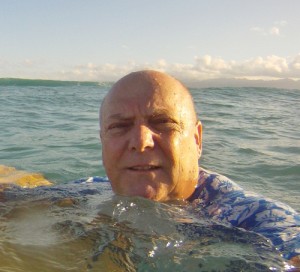
Stan in the water, ca. 2012.
|
2. What were your early boards based on? What was the construction process?
After seeing some of the designs ridden by
other surfers I decided to try and press my own boards. I particularly
liked Harry Akisada's boards although his boards have a little too much scoop
in the nose for me [see a picture of one of Harry's boards in the Larry Goddard paipo interview]. I learned that some people use concrete to press
laminated plywood together and others used water to weigh down the top of
the mold. I didn't have a lot of space to store a big or heavy mold,
so I hit on the idea of just using bolts and washers to pull mold
pieces together. So if you look at all my board designs you'll see at
least one hole in the middle of the scoop area that's been filled in
with putty or epoxy because that's where the top part of the mold is
pulled into the bottom part. My mold is made of plywood with the
bottom section reinforced with two by fours and the shape of the board
built up with layers of 1/8 inch plywood. The top of the mold is
actually separate pieces which are pulled into the bottom of the mold
with 5/8 inch bolts and nuts. My current mold requires six holes be
drilled in the board. The additional one hole in the scoop and four
holes are used to shape the tracks and the rails on the back edges of
the board. My boards are specifically made for knee riding, so they
have noticeably less scoop in the front than Harry's. The backside is
designed to grab the wave and hold on even without my legs and fins in
the water. Unless it's extremely choppy my boards hold tight on the
steepest walls even when I'm on my knees.
Stan's drawing of his mold.

3. Paipo riders have told me paipo were ridden all around Oahu in the
1960s, particularly on the South Shore and around Makapu'u. What are
your recollections of this period, the boards that were in use and the
standout paipo riders?
The only
commercially made board I recall from the 1960s and 70s was called
"Paipo Nui" and I think it was built by Greg Knoll. It was about 3/8 of
an inch thick made of mahogany plywood and not fiberglassed, but just
varnished. The scoop was sanded into the front and the back was
completely flat with the back rail rounded so that you wouldn't catch
the backside as you pulled yourself on to the board. It actually
resembled the modern-day sand sliding board, just a more rounded nose.
It was about 20 inches wide at the back in about 36-40 inches long.
Virtually all the other boards were homemade and designs varied widely.
Generally, I didn't surf anywhere but Makapu`u unless there was a
surfing contest. Consequently the surfers I knew were strictly from the
Eastside, Makapu`u or Sandy Beach. The best one I recall was named
George Paku Junior. His parents were the caretakers for Makapu`u Beach
Park. He was my high school classmate and he lived in Waimanalo. He
could surf on anything from a scrap piece of wood to McDonald's serving
trays and make it look beautiful fluid and easy. (As a side note,in
Hawaii, before the "Boogie Board" came along, it was common to see
serving trays with holes drilled in them at fast food restaurants
because folks who couldn't afford paipos would use a large tray to surf
with. The holes made stolen trays impractical for surfing on.) But,
George died in a car accident before he was even 25, and I don't think
there are even any photos of him surfing. He was the best I ever saw on
a paipo. The only other names I recall besides Harry were Mercer
Aikala, Frank Lee, Craig Matthews, Bud Scelsa, and Wayne Bartlett, but there
were others.
4. Paipo boards have been ridden prone,
kneeling and stand-up. How did you come to ride paipo kneeling? Was
this a common style at the time?
I think I started
knee riding just for the challenge. Several folks knee rode at Makapu`u,
but I think what keeps people from knee riding is the pounding that
your knees take. For some reason, even at age 56, and with no deck-pads
on any of my boards, my knees don't bother me. I usually only ride
lying down on a large wave at a break I'm not used to yet, with a steep
face and a late takeoff. A paipo requires a late takeoff in most cases,
but once it's moving, it accelerates quickly across the wave.
Consequently, if I'm surfing at a break with regular surfboards,
sometimes I'll stay on my stomach to accelerate away from them before I
get on my knees.
5. What is the advantage of riding paipo kneeling?
I think the
biggest advantage to knee riding on a paipo is you get a better view,
but also allows you to do more aggressive manoeuvres and it is more
challenging.
6. Who do you recall surfing paipo with in the early days and since then? Was there much individuality in how paipo were ridden?
In the mid-1970s,
after college, I got to the beach less and had to work more. In the
early-1980s, I joined the military and spent a couple years away from
Hawaii so I lost touch with a lot of my surfing friends. When I came
home I still only surfed at Makapu`u, but only a few times a year. About
10 years ago, in 2000, I moved to an office on Diamond Head. Since then
I've been able to surf in the mornings at Diamond Head, at least in the
summer months. I developed a closer paipo boarding friendship with John
Clark then, because I only knew him from the Fire Department before
that. This summer I actually started surfing at "Publics" in Waikiki
and got re-acquainted with Bud Scelsa. Most of the folks I surfed with I
mentioned in question 3 and I hardly ever see them. As far as styles,
there were some variations in style that made everyone just a little
different. Some of that may have been the board design or body weight
or some other variable. When we ran contests, however, the judging
criteria was: size of the wave, length of the ride, position on the
wave (staying close to the curl) and any manoeuvres or tricks
(spinners, riding backwards, etc). I must say though that I admired
George Paku's particular style. At 17 years old, he weighed about 225
pounds, but that big Hawaiian looked as graceful as an Olympic skater,
no matter how big the wave. His timing and ability to "use" every bit
of the wave was fluid and exceptional. If I had to say what style I
tried to copy, or influenced me the most, it would certainly be George
Paku's style.
Pictured on the right: Stan on the North Shore, ca. 1972.
|

|
6. Who do you recall surfing paipo with in the early days and since then? Was there much individuality in how paipo were ridden?
In the mid-1970s,
after college, I got to the beach less and had to work more. In the
early-1980s, I joined the military and spent a couple years away from
Hawaii so I lost touch with a lot of my surfing friends. When I came
home I still only surfed at Makapu`u, but only a few times a year. About
10 years ago, in 2000, I moved to an office on Diamond Head. Since then
I've been able to surf in the mornings at Diamond Head, at least in the
summer months. I developed a closer paipo boarding friendship with John
Clark then, because I only knew him from the Fire Department before
that. This summer I actually started surfing at "Publics" in Waikiki
and got re-acquainted with Bud Scelsa. Most of the folks I surfed with I
mentioned in question 3 and I hardly ever see them. As far as styles,
there were some variations in style that made everyone just a little
different. Some of that may have been the board design or body weight
or some other variable. When we ran contests, however, the judging
criteria was: size of the wave, length of the ride, position on the
wave (staying close to the curl) and any manoeuvres or tricks
(spinners, riding backwards, etc). I must say though that I admired
George Paku's particular style. At 17 years old, he weighed about 225
pounds, but that big Hawaiian looked as graceful as an Olympic skater,
no matter how big the wave. His timing and ability to "use" every bit
of the wave was fluid and exceptional. If I had to say what style I
tried to copy, or influenced me the most, it would certainly be George
Paku's style.
7. Have you ridden foam/fiberglass paipo or mostly wood boards?
I made a foam
paipo with a short skeg in the early 1970s, didn't like it and trashed
it after just a few sessions. It was not as manoeuvrable, and it was
too buoyant and hard to get under larger waves.
8. I believe you experimented with skegs,
or "runners." What were these like and were they positioned like
surfboard fins? What are your thoughts regarding fins on paipo?
On two of my
early boards that I used strictly on large waves (over 8 feet), I had
short, solid fiberglass "runners" at the widest back corners of the
board, about 3 inches in from the rail. The runners were only about an
inch high and 3/8 of an inch wide with no sharp edges and tapered into
the board on the front and back ends. I screwed them on through the
deck so I could remove them in a contest if the judges didn't like
them, but they were critical on my earlier boards when riding a steep,
hollow wave like Pipeline. My new boards do not need runners to achieve
the same control and my new design has less drag. I don't have any
pictures or samples of the old runners, but I'll draw some sketches and
scan them for you.
Stan's drawing of his board with runners

9. I read that your boards have a shape
like a taro leaf. What are the other design features of your boards
(e.g., dimensions, bottom shape, rail line)?
Although I still
experiment with the shape a bit, I feel my current generation of design
comes very close to meeting my definition of near-perfect surfing
board: light, stiff, low drag, high speed, nimble, and it fits easily
inside my Mini Cooper. In plan form my board resembles the Paipo Nui
[see two photos
of Paipo Nui in the Sean Ross Paipo Interview], except it is a full
four feet long with a width varying from 28 to 32
inches, and the back of my board is shaped a lot like the base of a
taro leaf (see figure below). If you look at the side profile of my
board you will see
that the scoop starts almost the midpoint and slowly sweeps up to about
1.5 inches. Where the scoop starts at zero the rails slowly start to
turn down on the two back corners (and this is where a picture would
really help, because it's hard to explain in words) but the rails never
go "below zero". When you look forward from behind the board, you will
see that the board is completely flat through the middle of the board
until you get to about 5 inches from center line, where the board
turns up about 3/4 inches and then down to zero at the rail. This forms
two
parallel channels on the back corners of the board, and that becomes my
planning surface and skeg combined. It will hold a wall, but if you
need to, you can still ride 10 inches of white water as far as it will
push
you to the beach, there is little drag to slow you down (so long as the
channels are parallel). [Note: The four bolts that pull the aft end of
the blank into the mould are 10" apart, the tunnel height is 3/4", but
I can move the center of the tunnels about 2", left or right based on
how wide the board is or how I want the tunnel shaped.]
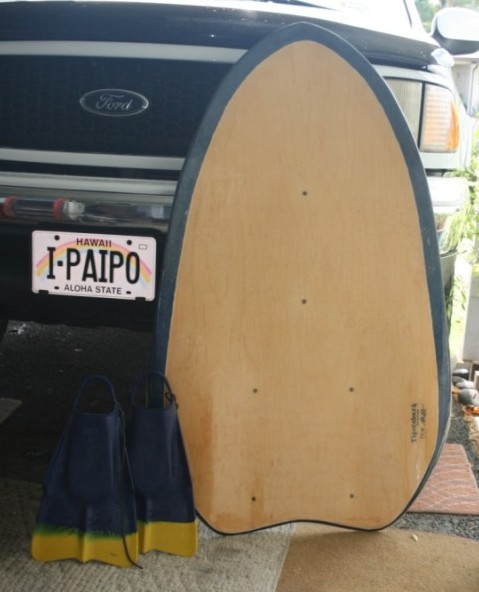 |
|
Stan Osserman's newest board
(ca. November 2010).
Photo by Stan Osserman
"This is my newest board (as of yesterday
it now has a camera mount on the nose too; not in this photo though).
This shot gives you a feel for my "taro leaf" description.
For my whole
life I used "Custom Duck Feet" (Voit), but I switched to "DaFin" this year
(pictured to the left of the board) at the recommendation of the lifeguards, and
I must admit, they are great! The DaFin gives me more power and they are more
comfortable. They are very hard to find right now for some reason!"
Compare the board's plan shape to the shape of a Taro leaf.

|
Four boards.
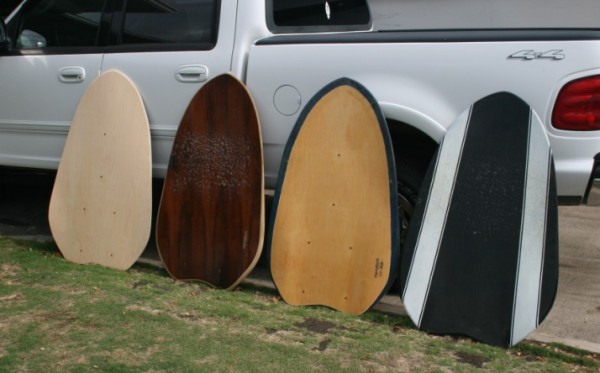
The board on the left is an
unfinished 1/2" blank bottom-side facing out (a little wider than my
standard board and thicker
too. An experiment I haven't completed yet.). I gave a 3/8" blank like
this to John Clark. He glassed it, but I don't know what he used for
glass or resin and he thought it was too wide. I tend to agree, so I
may reshape this one.
The board second from the left has a Koa veneer on
top. This board is thicker (1/2") and heavier than the last two and is
made for bigger waves (stiffer and heavy for easier take-off). The
third board is my newest one, light and fast with a little flex, 3/8"
thick and 4 oz. glass and epoxy. The black board is almost identical to
the one next to it, but it's painted to match my Mini Cooper.
Photo by Stan Osserman.
|
10. Without giving away too many secrets, what is involved in making one of your boards? How does your press work?
The base of the
mold is a 3/4 inch sheet of plywood 2x4 feet. I stiffen the plywood in the long
axis with 2x4s glued and screwed to the ply. I build up the front
edge of the plywood to the shape of my scoop, and I put two 'half
dowels" where I want my tracks to be. There are four bolts that pull
the back flat down to the base and one bolt that pulls a shaped piece
of plywood down into the scoop to form the front. I use wedges pounded
under the wood that forms the back of the board to force the back rails
downward. I use 1/8" maple, birch or mahogany plywood, either 3 or four
layers for the blanks. Occasionally I will use one sheet of 1/4 inch ply
and two 1/8 inche ply's if I want to have a koa wood top on the board. I
like Weldwood Plastic Resin glue to do the laminating, but regular
Tightbond woodworking glue is fine as well. Apply the glue with a
notched trowel with small notches. I let it dry over night, pop it out
of the mold, plug the holes then shape the edges as I like, then glass
with epoxy or polyester resin and 4 oz. glass.
The bottom of the board looking forward and gives a feel for the shape in the aft end.

Photo by Stan Osserman.
Looking front to back with the bottom up.
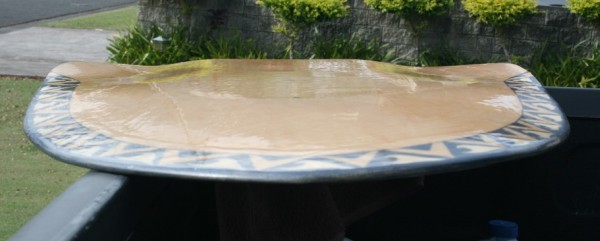
Photo by Stan Osserman.
A pure profile of the aft end of the board with the bottom facing up.

Photo by Stan Osserman.
11. What is the story of you being a 'test pilot' for the early Morey boards?
Wayne Bartlett
had a friend named Rich Parr who owned a surf shop on Queen Street in
Kaka`ako, near the Queen's Theater. One day Wayne got a call to come by
the shop and check out the Morey Boogie Board. Rich was into long boards
and big wave boards and didn't know much about paipos, so he asked
Wayne and I to test out the Boogie Board and tell him what we thought about
it before he invested in any inventory. I don't recall the year, but it
would be 1969-1972. So we took the Boogie board to Makapu`u and ran it through
its paces. We liked it, and I recall telling Rich, "It's fun; not as
fast as a paipo, but faster than an air mattress, and easy to
manoeuvre, but at $25 each, it's too expensive for most folks." Guess
that's why I'm not a millionaire today! Not long after that, however,
Rich had to close his shop and move to the mainland for personal
reasons, so he never got a chance to market the Boogie in Hawaii anyway.
12. When did the Makapu'u Bodysurfing Association (MBA) start?
Again, it had to
be 1969-1971, but if I run across my membership card I'm sure I can
narrow the date down. I don't think it's still in existence though.
13. In Australia board riding clubs range
from being super competitive to social clubs. What was the aim of the Makapu'u Bodysurfing Association? How often were meets held and what did they consist of?
The main aim of
the club was to run contests with a slightly lesser role of being a
social club. But like a lot of great efforts here in Hawaii, when the
administration of a formal organization gets too cumbersome, the thing
just fizzles out. And I don't know if the Makapu`u Bodysurfing
association still exists or how long it lasted, but it was losing
momentum as I stepped away to join the military.
14. What would you have to do to get a high scoring ride or to win a meet?
My strategy in a
contest was to catch three waves in rapid succession, then look for the
biggest waves I could catch and go for quality/ tricks and long ride.
Usually only 5 rides were scored, they would take the top 7 waves,
eliminate the highest and lowest scoring wave on each judges card, and
give you points for the 5 waves (or however many you got). Size of
wave, length of ride, staying in the critical spot the longest, and
tricks were the big point items. We tried to have 5 judges, but would
use as few as 3 if we were short. Contestants would wear colored life
guard caps (modelled after Australia), and we would have spotters call
out the colors so judges could concentrate on scoring.
15. You sent me some photos taken at a
North Shore bodysurfing contest, which included "Open Paipo" and
"Hawaiian Paipo" divisions. How did these divisions differ and who
stood
out in these contests?
The "Open Paipo"
division allowed foam boards with skegs and was unique to contests we
held on the north shore, because at Makapu`u, Sandy Beach and Point
Panic, the usual contest spots other than the North Shore, skegs were
not allowed. So, on the North Shore we had two divisions. I don't
recall anyone as a stand-out in particular.
Photos were taken during a North Shore bodysurfing contest back in the early-1970s, at Pipeline.
 |
|
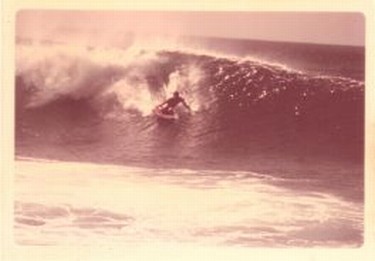 |
Photos by: Wayne Bartlett. |
Photos were taken during a North Shore bodysurfing contest back in the early-1970s, at Ehukai.
 |
|
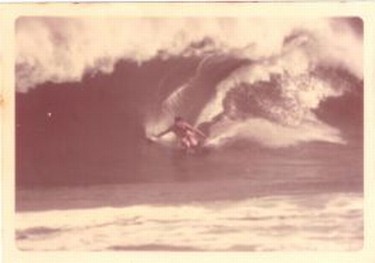 |
Photos by: Wayne Bartlett.
|
16. I've heard Harry Akisada has won a few contests. What is it about
his surfing that stands out? Actually, I don't recall Harry ever
entering a contest.
He may have entered some at Makaha, or in Town,
when I was away from Hawaii, but Harry liked surfing, not competing.
There is no doubt in my mind that he would have been in the top spot in
many a contest if he chose to compete, but he usually chose not to.
Quite honestly, the biggest attraction to competition for many of us
was just to get out on a big day with six of our friends and no novice
knuckleheads getting in the way for a couple half hour sessions! Think
about having Banzai Pipeline pretty much to yourself, on a paipo, for a
half hour on a really nice day!!!
17. What has been the attraction of riding paipo?
I'm a minimalist
for the most part. Paipo's are compact, you don't need (and probably
wouldn't want) a leash, you can dive down 2 to 10 feet to get under large
waves and pop up all alone after all the surfers get cleaned out by the
big set, it's still a novelty after all these years, fast, fun, close
to the water, and I build them just the way I want them. I'll never
switch to surfing anything else.
18. Any waves or surfs stand out for you? What type of wave are paipo best suited for?
Generally
speaking, a paipo requires a fairly late take off, but it also
accelerates fast and that's a great rush. I wish I could report that
I've surfed hundreds of spots, but I haven't. Here's a rundown of my
favourites, and why;
Publics - I think it's hard to beat Publics
on a big, clean south swell. The wave peels off in a very long wall
that seems to let you ride for hours. The down side is that it can get
crowded, and it is a bit shallow inside. Nice on a small day, fantastic
on a big day and usually little wind in the early morning.
Makapu`u - It's a beast! On a big day, it's
fast and offers lefts and rights. It can be pretty bumpy but on a clean
day it's a thick, fast , freight train of a wave. When it's big, only
the regulars are out there.
Diamond Head - My second "home" in the summer
time dawn patrol. Almost always has surf in the summer. When it's big
and clean it's great, but when it gets over 8 feet it can be
deceptively dangerous.
Pipeline (and even Sunset Beach) - Great wave, if you can find room nowadays!
Most of the rest of the spots I've tried
haven't been consistent enough to spend a lot of time at. I stick with
the locations and crowds that I'm used to. I would like to try Makaha
some time, but it's a long drive!
19. Any other comments?
I've tried just
about every kind of surfing you can imagine, long boards, hand-boards,
rigid air mattress, boats, canoes, body boards, and just plain
body surfing, but I always go back to paipo and I know that will never
change. Aloha,
A close up of my company logo. I don't
sell paipo boards, but I do custom woodwork and use the logo on my
boards. I finished this board on the 9th anniversary of my dad's death,
so I added "for Dad" on my latest board.

Yes, the widest part of my board is farther forward than most, and certainly
farther forward than the HPD or Paipo Nui and even Harry's boards. All
these photo's are mine. Aloha.
|
|














